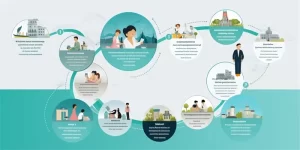Artificial Intelligence (AI) has made remarkable strides in recent years and has revolutionized various industries. One area that has benefited greatly from AI is education. With customized learning and personalized tutoring, AI has empowered educators and learners alike. In this article, we will explore the numerous ways AI is transforming education.

1. Adaptive Learning
Adaptive learning platforms utilize AI algorithms to tailor educational content and activities based on individual student needs. By analyzing student performance and learning patterns, these platforms can provide personalized recommendations, ensuring that students receive content at their level of understanding. As a result, students can progress at their own pace, enhancing their learning outcomes.
Some popular adaptive learning platforms include Knewton, DreamBox Learning, and Smart Sparrow. These platforms offer adaptive assessments, interactive lessons, and real-time feedback, bridging the gap between classroom teaching and individualized learning.
2. Intelligent Tutoring Systems
Intelligent Tutoring Systems (ITS) leverage AI to provide individualized instruction and support to students. These systems use natural language processing and machine learning algorithms to interact with students, analyzing their responses and providing personalized feedback. ITS can adapt their teaching style based on student needs, helping them grasp concepts more effectively.
One notable example of an ITS is Carnegie Learning’s MATHia, which provides personalized math instruction. It identifies knowledge gaps, presents customized lessons, and tracks progress, enabling students to improve their problem-solving skills.
3. Virtual Assistants
Virtual assistants, such as Amazon’s Alexa or Google Assistant, are becoming increasingly integrated into educational environments. These AI-powered assistants can answer student questions, provide instant information, and even help with homework. By using natural language processing, they offer a hands-free and interactive learning experience.
In addition to general-purpose assistants, there are specialized virtual assistants designed specifically for education, like IBM Watson Education Advisor. These virtual assistants can assist students with subject-specific queries and guide them through complex topics.
4. Personalized Content Generation
AI can generate personalized content tailored to each student’s learning requirements. For instance, tools like Boddle Learning and Quizlet allow educators to create customized quizzes and educational games. These platforms use AI algorithms to adapt the difficulty level and content of the activities based on individual students’ progress.
Moreover, AI-powered content generators, such as OpenAI’s GPT-3, can write essays, generate practice questions, and even create educational resources. This technology saves educators time while providing students with curated and relevant materials.
5. Automated Grading
AI-based automated grading systems can efficiently evaluate student assignments and provide immediate feedback. By analyzing parameters such as grammar, content, and structure, these systems generate scores and comments. This relieves educators from time-consuming grading tasks, allowing them to focus on other aspects of teaching, such as providing individualized support.
Platforms like Turnitin and Gradescope leverage AI algorithms to streamline feedback processes, making assessment more efficient and objective. However, it is essential to strike a balance between automated grading and human evaluation to ensure accurate and fair assessment.
6. Assistive and Inclusive Learning
AI-powered assistive technologies facilitate inclusive learning environments for students with disabilities or specific educational needs. For instance, voice recognition software assists students with dyslexia by transcribing spoken words into text. Similarly, AI-powered text-to-speech tools aid visually impaired students, enabling them to access written content.
Microsoft’s Learning Tools for OneNote and Read&Write by Texthelp are examples of assistive learning tools that utilize AI to support students with reading difficulties, enabling them to comprehend and engage with educational content more effectively.
7. Data Analytics and Personalized Recommendations
AI algorithms can analyze vast amounts of data collected from students’ interactions with learning systems. These analytics help identify learning patterns, areas of improvement, and effective teaching strategies. Based on this analysis, AI can provide personalized recommendations for further study materials or interventions if necessary.
Moreover, data-driven learning management platforms, such as Realizeit and Brightspace, offer educators insights into student progress and engagement, facilitating data-informed decision-making to enhance teaching effectiveness.
8. Time Management and Scheduling
AI-powered tools can assist students in managing their time effectively. Calendars and scheduling apps, like MyStudyLife and Google Calendar, utilize AI to prioritize tasks, create study plans, and remind students of upcoming deadlines. Using machine learning, these apps adapt to students’ study habits and dynamically adjust schedules to optimize productivity.
Furthermore, AI algorithms can generate personalized study recommendations based on individual learning goals and upcoming exams. These recommendations consider students’ past performance and suggest optimal study durations for different subjects or topics.
Frequently Asked Questions:
Q: Can AI replace human teachers?
A: AI serves as a powerful tool to enhance education, but it cannot replace human teachers. While AI can provide personalized assistance, adapt content delivery, and automate certain tasks, the human touch and emotional connection offered by teachers are invaluable in the learning process.
Q: Is AI in education affordable for all schools?
A: Implementing AI in education varies in cost depending on the scale and complexity of the system. While some AI tools and platforms may require a significant investment, there are open-source and low-cost alternatives available. Additionally, as AI continues to evolve, costs are expected to decrease, making it more accessible to a broader range of educational institutions.
Q: Does AI create a dependency on technology and reduce critical thinking skills?
A: AI in education is designed to complement and enhance learning, not replace critical thinking. By automating routine tasks and providing personalized support, it frees up students’ and teachers’ time for more meaningful learning experiences, encouraging higher-order thinking skills and creativity.
References:
1. Vélez, Z. (2020). Artificial Intelligence and the Future of Education. Edutopia. Retrieved from: https://www.edutopia.org/article/artificial-intelligence-and-future-education
2. Roettgers, J. (2021). AI Matures, Poised to Transform Education. EdTech Magazine. Retrieved from: https://edtechmagazine.com/k12/article/2021/08/ai-matures-poised-transform-education
3. OpenAI. (2021). OpenAI: GPT-3. Retrieved from: https://openai.com/blog/openai-and-the-future-of-education/








